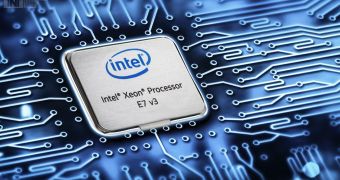Currently available at Oracle and other major corporate applications developers, Intel has sneaked its highest-performing x86 server micro-CPU up to date. The chip features on-the-fly reconfiguration core-count and frequency.
According to the guys at CPU World, the Xeon E7 features a whopping 18 cores Hyper-Threading technology, up to 45MB of last-level cache, two dual-channel DDR3/DDR4 memory controllers compatible with Jordan Creek 2 scalable memory buffer (SMB) that support up to 1536GB of memory per processor; 32 PCI Express 3.0 lanes; three 9.6GT/s QPI links to connect to other processors; and up to 175W thermal design power. The Xeon E7-8895 v3 operates at 2.60GHz base frequency and at 3.50GHz maximum turbo frequency. By contrast, the E7-8890 v3 works at 2.50GHz/3.30GHz clock-rates.
However...
Apparently, the new CPU is specially designed to allow customers to vary the core count and operating frequency at any given time, without any change in physical components or to require a system reboot! In fact, servers at Oracle are the only ones that have these features as these are innovations found in the system BIOS and operating system kernel software.
On the other hand, such a high amount of cores is rarely needed as each application is tailored to require only one typical processing type. Some apps that rely on single-thread processing will require lower core count CPUs with higher speeds, while others will require multiple cores for best performance. In this regard, on-the-fly configuration comes as a major breakthrough from Intel and it’s quite possible to keep these new Xeons in corporate servers where the adjacent systems, 3TB of DDR3 memory, 6.4TB of NVMe-based solid-state storage with up to 32GB/s bandwidth (or 7.2 TB of HDD storage), 11 PCIe 3.0 expansion slots and so on, can support such an outstanding BIOS feature.
It’s unknown if this high-performance platform will ever come to client PCs, and keeping in mind that the 3U form-factor servers, costing tens of thousands of dollars, are only available to corporate data centers, one can only imagine how pricey such a move to regular consumer market would eventually be.

 14 DAY TRIAL //
14 DAY TRIAL //